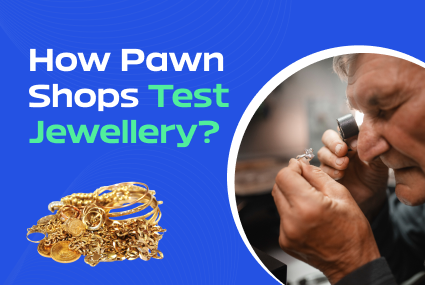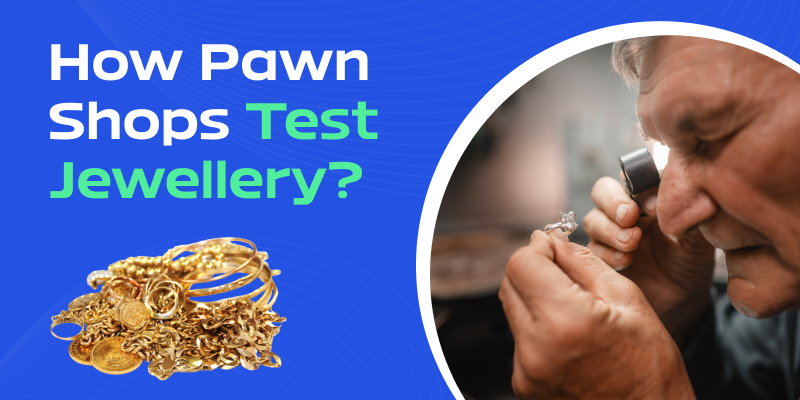

When you walk into a pawn shop with a piece of jewellery, you’re putting value on the counter. Whether it’s a gold chain, a diamond ring, or a family heirloom, you want to know how the shop figures out what it’s really worth. Pawn shops don’t just guess, they use several tests to check for authenticity, quality, and purity before making an offer.
Here’s a breakdown of how the process works and what you should know before selling or even taking out a loan against your jewellery.
Why Pawn Shops Test Jewellery
Gold and other precious metals are valuable, but they’re also commonly faked. Plated items, counterfeit hallmarks, and imitation stones aren’t unusual. Pawn shops have to protect themselves and their customers, so testing is essential. It ensures:
- The jewellery is genuine.
- The purity of the metal is clear.
- The value can be fairly estimated.
This is good news for you, too. A proper test means you’ll have confidence in the offer you receive.
First Step: Visual Inspection
The first thing a pawnbroker will do is look closely at the jewellery. They’ll check for hallmarks or stamps, such as “10K,” “14K,” or “18K” for gold. They’ll also look for signs of wear that might reveal if something is only gold-plated.
Magnifying tools or jeweller’s loupes are often used at this stage. Small details, like the way a clasp is made or whether a stone has natural inclusions, can reveal a lot about authenticity.
Magnet Test
Gold itself isn’t magnetic. So, one of the quickest checks is to hold a magnet near the jewellery. If it sticks, that’s a red flag. This doesn’t prove an item is fake—it could mean there are other metals mixed in, but it helps pawnbrokers spot potential issues right away.
Acid Testing
Acid testing is one of the most common methods used in pawn shops. A small scratch is made on a testing stone, and a drop of acid is applied. Different acid strengths are used depending on the karat being tested. If the mark dissolves, the gold isn’t pure at that level.
It’s worth noting that this test doesn’t damage your jewellery. The scratch is made on the stone, not directly on your piece.
Electronic Gold Testers
Many modern pawn shops also use electronic testers. These devices measure the electrical conductivity of the metal, which varies depending on the gold content. It’s a quick and reliable method, often used alongside acid testing for confirmation.
XRF Analyzers
Some pawn shops invest in advanced tools like X-ray fluorescence (XRF) analysers. These machines scan the surface of the jewellery and provide a breakdown of its metal composition. They’re precise and non-invasive, which makes them ideal for high-value pieces.
While not every shop has this technology, it’s becoming more common in larger or well-established businesses.
Diamond and Gemstone Testing
If your jewellery has gemstones, these are tested separately. Diamond testers measure thermal or electrical conductivity to check if a stone is real. For coloured gems like sapphires, rubies, or emeralds, pawnbrokers may use specialised tools or send the item for appraisal if needed.
Clarity, cut, and carat weight also affect the value, so expect a closer inspection if your jewellery contains stones.
How This Affects the Offer
Once testing is complete, the pawnbroker will have a clear idea of the item’s purity and weight. This information is combined with the current market price of gold or other metals to calculate its value.
For example, if you’re looking to sell gold jewellery, you’ll get an offer based on the purity and weight of your piece at the day’s market rate.
If you’re not ready to part with your jewellery, you also have the option to use it as collateral for a gold loan. This way, you get access to cash without losing ownership of your item. MegaCash offers this service, allowing you to borrow against the value of your jewellery.
What If You Just Need a Loan?
Sometimes, selling isn’t the best option. If you need short-term funds but want your jewellery back, you can use it to secure a cash loan in Sydney. The process is quick, and you only part with your item temporarily. Once the loan is repaid, you get your jewellery back safe and sound.
If you’re worried about security, you can read more here: How Safe Is Your Gold Jewellery at a Pawn Shop.
Tips Before You Visit a Pawn Shop
If you’re planning to bring in jewellery for testing, here are a few things to keep in mind:
- Know the basics: Check for hallmarks or stamps before you go.
- Clean your jewellery: A quick polish can make details easier to see.
- Weigh your item: Having a rough idea of its weight helps.
- Do a little research: Look up current gold prices to get a sense of what to expect.
The more informed you are, the more confident you’ll feel when the pawnbroker makes an offer.
Final Thoughts
Pawn shops rely on accurate testing to ensure they’re dealing with genuine pieces and to give you a fair offer. From visual checks to advanced XRF analysis, the process is designed to separate real value from imitations.
Whether you want to sell gold jewellery outright or use it for a loan to cover short-term needs, knowing how testing works helps you make better decisions.
If you’re curious about what your jewellery is worth, don’t guess, get it checked.
Get a free estimation today: Sell your gold in 3 easy steps.
Why Pawn Shops Test Jewellery



